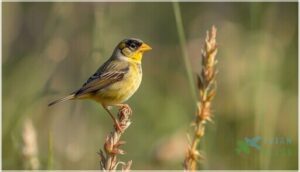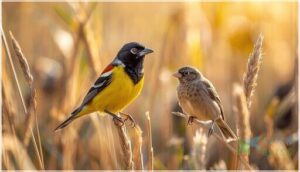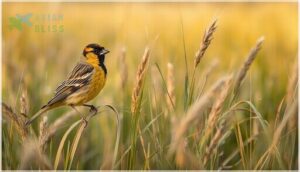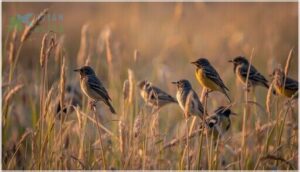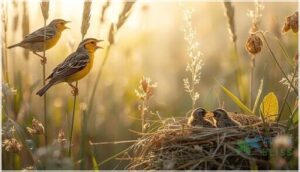This site is supported by our readers. We may earn a commission, at no cost to you, if you purchase through links.
Step into a summer field after the rain, and you might hear a sound that belongs nowhere else: the distinct, metallic call of the dickcissel. This small grassland bird, plump and round, flashes a yellow breast and a jet-black bib as it perches atop a swaying stalk, staking its claim in the open expanse.
For years, farmers and naturalists alike have watched the dickcissel sweep across the prairies, a sign of healthy land and shifting seasons. If you’re curious about its journey, from dusty migration routes to patchwork meadows, you’re in the right place.
Table Of Contents
- Key Takeaways
- What is a Dickcissel?
- Physical Characteristics and Identification
- Habitat and Geographic Distribution
- Behavior, Diet, and Vocalizations
- Conservation Status and Threats
- Frequently Asked Questions (FAQs)
- What does a dickcissel call look like?
- Where do dickcissel live?
- Are Dickcissels extinct?
- Are dickcissel birds warm-blooded?
- What do Dickcissels do?
- Do Dickcissels live in the Midwest?
- What is the origin of the dickcissels unusual name?
- How long do dickcissels typically live in the wild?
- Can dickcissels be kept as pets or in aviaries?
- Do dickcissels have any cultural significance or folklore associations?
- Conclusion
Key Takeaways
- Dickcissels are small, seed-eating grassland birds recognized by a yellow breast, black throat patch, and distinct, metallic song.
- Their populations shift due to habitat changes, with core breeding grounds in the central Great Plains and wintering grounds in Central and northern South America.
- Habitat loss, pesticides, and climate extremes are major threats, but stable overall numbers rely on healthy grasslands and ongoing conservation.
- Males and females look different, with males showing brighter plumage, while Dickcissels play a key role as an indicator of grassland health.
What is a Dickcissel?
If you’re curious about the dickcissel, you’re in the right place. There’s more to this small bird than first meets the eye.
Let’s look at how it’s classified, some interesting names it goes by, and what history tells us about its range.
Taxonomy and Classification
Every avian enthusiast who studies the Dickcissel confronts a fascinating taxonomy. Here’s how it breaks down:
- Family Cardinalidae—seed-eaters with hefty bills.
- Genus Spiza—where Dickcissel sits alone.
- Species Spiza americana—no recognized subspecies.
- Phylogenetic analysis confirms its genetic uniqueness, despite a history of shifting classifications and past debates over subspecies.
Dickcissels are primarily found in open grasslands.
Common Names and Etymology
The Dickcissel’s name springs from its cheerful song—a direct echo of “dick-dick-ciss-ciss”—cementing its cultural significance in grassland birding circles.
While “Dickcissel” leads in name frequency, you still find historical names like “black-throated bunting” and “Townsend’s dickcissel.” In Spanish-speaking regions, “arrocero” hints at this Spiza americana’s ties to rice fields.
These birds are approximately six to seven inches in height.
Historical Discovery and Range
Early sightings of the Dickcissel reveal a bird with a knack for surprise. This species’ avian range shifted dramatically over decades, responding to habitat influence and frequent range shifts. You’ll notice in range maps that irruptive behavior defines much of its story. Recent trends show a breeding range still anchored in the central plains, but always on the move.
- Early sightings in Pennsylvania and New England
- Range shifts tied to changing grasslands
- Habitat influence from agriculture and restoration
- Irruptive behavior causes sudden population jumps
- Recent trends keep the breeding range in flux
Physical Characteristics and Identification
Spotting a Dickcissel starts with knowing what features set it apart. There are a few key things you’ll want to watch for.
Here’s what you should keep in mind as you look closer.
Size, Shape, and Measurements
Can you spot the difference between a sparrow and something just a notch bolder? Body proportions set the Dickcissel apart. Measure its length—6 to 7 inches—then check the bright, thick bill and short tail.
Juvenile size almost matches adults, with little regional variation. Sexual dimorphism shows up most in weight and head size, not wingspan.
| Measurement | Range | Details |
|---|---|---|
| Length | 6–7 in | Compact, stocky |
| Weight | 0.9–1.4 oz | Shows Sexual Dimorphism |
| Wingspan | 10 in | Consistent, broad |
Male Vs. Female Appearance
Plumage differences speak volumes in a Dickcissel flock. You’ll see size dimorphism too—males are bigger, bulkier, and boldly marked. The male’s black bib, bright yellow chest, and chestnut shoulder patches stand out.
Females wear muted color patterns, lack the throat patch, and show subtle facial markings. These subtle traits simplify field identification, even in mixed company.
Distinctive Color Patterns
In the open fields, you’ll notice a vivid mix of color patterns: a male’s bright yellow chest and black “V” contrast with chestnut wing patches, while female markings stay earth-toned and subtle. Seasonal changes bring softer hues after breeding, and regional variations create small but noticeable shifts. Even rare, aberrant coloration can surprise the most careful observer.
- Male Plumage stands out during breeding, with intense yellow and bold black throat patches.
- Female Markings remain subdued, blending soft browns and faint yellow highlights for camouflage.
- Seasonal Changes and Regional Variations impact the intensity and clarity of Dickcissel color pattern, especially after molt or outside the core range.
Bill, Tail, and Wing Features
Think of the Dickcissel’s bill as a built-in multi-tool—its thick, conical shape is perfect for husking seeds, an unmistakable feature among avian species characteristics. The short, square-tipped tail boosts aerodynamics, while pointed wings with chestnut patches provide efficient flight mechanics.
Subtle sexual dimorphism shows up in slightly larger bill and wing sizes for males, shaping their signature plumage characteristics.
Juvenile and Seasonal Variations
Ever wonder how Dickcissels stay hidden in plain sight? Juvenile plumage gives young birds a muted look, blending easily into grasslands. Notice how these changes play out:
- Duller, less-distinct streaks on juveniles
- Seasonal molt from June through October
- Gradual morphological changes, especially wings
- Shifts in coloration after migration patterns
- Developmental timing guiding post-fledging survival
You’ll spot variety, especially during fall migration.
Habitat and Geographic Distribution
Knowing where Dickcissels live and travel tells you a lot about how they survive. Their choice of home shapes every part of their life.
Here’s what you need to know about their habitats and the places they call home.
Preferred Habitats (Grasslands, Meadows, Fields)
What makes a field feel like home for a Dickcissel? You’ll find them in native grasslands, CRP fields, and meadows rich in forbs. Prairie habitat with moderate grazing, restored edge habitats, and dense herbaceous cover all boost Dickcissel habitat quality. Grassland management and habitat restoration shape their world—each patch offering something unique.
| Habitat Type | Features | Why It Matters |
|---|---|---|
| Native Grassland | Forb abundance, litter | Nesting, food, cover |
| CRP Fields | Dense herb, edge | Nest success, stability |
| Meadows | Tall forbs, open spaces | Foraging, safety |
| Hayfields | High density, diversity | Breeding, food |
| Edge Habitats | Borders, mixed structure | Adaptability, access |
Breeding and Wintering Ranges
Imagine this: the heart of summer finds Dickcissels nesting in tall grass from Nebraska to Texas, where Range Expansion or sudden Population Shifts can change everything. After breeding, flocks surge south onto wintering grounds—in Venezuela’s llanos or Mexico’s savannas. Geographic range, Winter roosts, Habitat Loss, and Climate Impact shape where you’ll find them season after season.
- Breeding grounds—central Great Plains
- Peripheral nesting—Midwest, edge states
- Migration Routes—through North America
- Wintering range—Mexico, Central, northern South America
Migration Patterns and Routes
Dickcissel migration patterns are all about movement on a grand scale. Each spring, flocks of hundreds to thousands push north, with migration timing peaking from late March into May.
Their journey stretches over 3,500 kilometers, weaving across fields, water bodies, and stopover habitats. Route variations let these birds adapt, showing the flexible, adventurous nature of avian migration.
Regional Occurrence in North America
After migration peaks, you’ll spot the Dickcissel scattered across North America, but not everywhere equally. Core Breeding Areas stretch from Nebraska to Texas and across the Midwest.
Population Density Shifts are common—sometimes big flocks boom and then vanish the next year. Occasional Eastward Expansion, rare Vagrant Sightings, and Population Trend Analysis make their bird range and distribution a case study in adaptation.
Behavior, Diet, and Vocalizations
Regarding the dickcissel, plenty is happening beyond what you see at first glance. Let’s take a closer look at how these birds feed, connect with each other, raise their young, and make themselves heard.
Here’s what you can expect as we break down their daily lives.
Foraging and Feeding Habits
You’ll often spot this bird working the ground or low grass, shifting with the seasons and what’s on the menu. Here’s what shapes Dickcissel diet and feeding:
- High insect consumption in breeding season
- Shift to seed diet in fall/winter
- Diverse foraging locations
- Distinct feeding behavior
- Notable agricultural impact
Social and Flocking Behavior
When you see groups shift across the grass, you’re witnessing flocking behavior in action. Winter roosts can swell to thousands, relying on tight flock communication and collective predator response.
Social hierarchy fades outside breeding season—every bird fits in a mixed flock.
Watch for calm, synchronized flight and lively calls—signs of adaptable Dickcissel behavior and classic avian roosting dynamics at work.
Nesting and Breeding Practices
Across open grasslands, you’ll spot nests tucked low in thick grass—carefully chosen Nest Site Selection is key. Females handle nest weaving alone, then lay 3–6 eggs. Clutch Size Variation kicks in with the season.
A quick Incubation Period—about 13 days—leads to attentive Parental Care, boosting Fledging Success, especially on stable breeding grounds with safer nesting habits.
Typical Songs and Calls
When you listen for dickcissels during spring, you notice their avian vocalizations—crisp, repeated bursts from perches high on grass stalks. Their song structure is rhythmic and bold, but you’ll hear calls change with the season and place.
Picture these:
- Sprightly primary songs in May
- Buzzy flight calls
- Sharp alarm notes during disputes
Conservation Status and Threats
Regarding the Dickcissel, keeping track of its numbers and challenges is important. Understanding what puts this bird at risk helps you see why conservation matters.
Here’s what you need to know as we look at these key points.
Current Population Trends
Think of a balance that keeps tipping but never fully topples—that’s the story of the Dickcissel today. While historic Regional Declines marked their past, most populations now show signs of stability.
Habitat Influence shapes where these birds thrive, and shifts in migration patterns impact local numbers.
The conservation status remains stable, though monitoring population decline helps guide future outlooks.
Major Threats and Challenges
Habitat Fragmentation and habitat loss cut the land beneath Dickcissel nests, while Pesticide Poisoning sweeps through their flocks each season. Direct Mortality from persecution and collisions stacks the odds, and climate threats add another layer—harsh years bring floods or droughts.
Habitat loss, pesticides, collisions, and climate extremes combine to threaten Dickcissel populations in grasslands each year
Nest Predation, fueled by agricultural practices and changing weather, keeps population decline an ever-present conservation challenge.
Conservation Efforts and Strategies
You can help keep the Dickcissel’s future bright by backing Habitat Restoration in grasslands and supporting Breeding Management that promotes dense, undisturbed cover. Population Monitoring gives us the data to shape smart conservation efforts, while Conservation Partnerships bring together agencies, landowners, and farmers.
Embracing sustainable farming practices, these conservation initiatives pave the way for Future Directions in Dickcissel conservation.
Impact of Climate Change and Habitat Loss
Extreme Weather and habitat loss are changing the story for Dickcissels. When rain storms flood nests or drought shrinks prairie, fewer young survive. Brood parasitism spikes after harsh springs, too.
You’ll see these birds skip spots they once filled—a clear Population Decline linked to climate change impacts on birds, habitat fragmentation, and shifting Migration routes.
The Dickcissel conservation status remains uncertain.
Frequently Asked Questions (FAQs)
What does a dickcissel call look like?
If bird calls had their own mixtape, this one would stand out. A dickcissel’s call is buzzy and sharp, running from 0 to 5 kHz. Its rhythmic pattern is distinct—think “dick-dick-cissel.”
Where do dickcissel live?
You’ll find Dickcissels in open grasslands, meadows, and prairies across the Midwest, especially during breeding.
Their habitat preferences shift during migration stopovers; many winter in dense agricultural fields of Venezuela.
Habitat fragmentation can affect their range expansion.
Are Dickcissels extinct?
Dickcissels aren’t extinct, though local extinctions and range shifts have happened. Historical disappearance in some regions and ongoing habitat loss cause population declines.
Conservation efforts target these challenges, looking at reintroduction efforts and future projections for their status.
Are dickcissel birds warm-blooded?
Spiza americana is an avian species with warm-blooded traits, relying on Thermoregulation Mechanisms and high Metabolic Rates.
Energy Conservation lets these birds withstand broad Temperature Tolerance ranges, which is essential for survival as Climate Impacts intensify.
What do Dickcissels do?
On a summer morning, you might witness fierce nest defense and foraging flocks sweeping grasslands.
Dickcissel behavior and habitat include male polygyny, female infanticide, communal roosting, nesting behavior, persistent vocal learning, and strong territorial behavior year-round.
Do Dickcissels live in the Midwest?
Native grasslands and conservation sites across the Central United States offer Midwest Abundance for these birds. Look for them weaving through tallgrass prairie ecosystems, where shifting Breeding Patterns, Population Trends, and Habitat Preferences guide their Seasonal Movements each year.
What is the origin of the dickcissels unusual name?
It’s almost as if their name leapt straight from their throats—sharp “dick, dick” notes followed by “ciss, ciss, ciss.” This name onomatopoeia mirrors their song, a hallmark of avian nomenclature and common usage.
How long do dickcissels typically live in the wild?
Dickcissels usually live around four years in the wild, but most don’t make it past their first year.
Many factors—high juvenile mortality, habitat loss, and migration stress—drive population turnover and keep average survival rates low.
Can dickcissels be kept as pets or in aviaries?
Legal restrictions and welfare concerns mean you can’t keep this grassland bird as a pet.
Their behavior, specialized habitat needs, and conservation status also raise major ethical and practical barriers—aviculture prevalence is effectively zero for conservation challenges alone.
Do dickcissels have any cultural significance or folklore associations?
Picture a hidden thread running through America’s prairies: birdsong shaping art, guiding crops, and sparking classroom awe.
Through symbolism, indigenous contexts, and nature education, the dickcissel’s habitat, behavior, and agricultural role weave lasting artistic influence and meaning.
Conclusion
When the fields grow silent, something’s quietly missing—a soft-spoken sentinel that signals well-tended grasslands. To spot a dickcissel is to find proof of open space, thriving life, and the wild machinery of migration at work.
If you find yourself near waving grasses and a quick flicker of yellow, take note: this isn’t just a bird in the brush. It’s a measure of the land’s health and the resilient spirit that carries nature through every season.
- https://www.audubon.org/field-guide/bird/dickcissel
- https://en.wikipedia.org/wiki/Dickcissel
- https://www.mbr-pwrc.usgs.gov/bbs/grass/a6040.htm
- https://explorer.natureserve.org/Taxon/ELEMENT_GLOBAL.2.106001/Spiza_americana
- https://wildlife-species.canada.ca/bird-status/oiseau-bird-eng.aspx?sY=2019&sL=e&sM=a&sB=DICK


